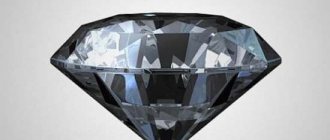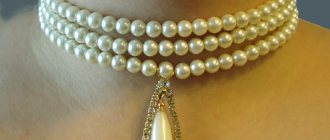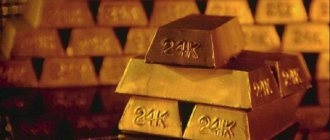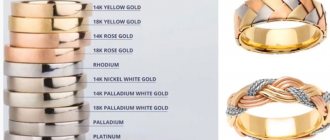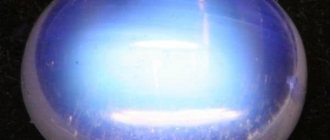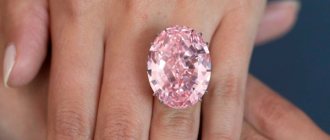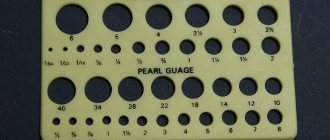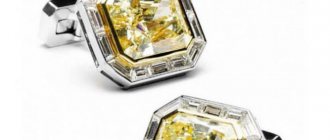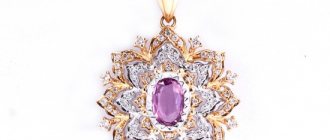A diamond is a diamond cut in a certain way. The main property of this mineral is its extreme hardness, which is why they learned to cut it quite late. But since 1465, when the Fleming Lodewijk van Berkem first created facets (facets) on a diamond, the diamond has remained the most expensive and popular gemstone.
The cost of 1 carat (0.2 grams) on the retail market starts from 40-50 thousand rubles for small stones of average quality and exceeds 2,000,000 rubles for larger specimens with good characteristics.
Why are diamonds so expensive?
Diamonds have a number of rare qualities - hardness, wear resistance, and the ability to exist indefinitely without losing quality. Unique optical characteristics - the ability to decompose white light into colored rays, providing a bewitching “game” and shine.
Diamonds are rare nuggets and only 20% of mined minerals are suitable for jewelry processing. It is estimated that to obtain a 1-carat diamond it is necessary to process about 250 tons of ore.
But the main value of a diamond is created by jewelers - it is the skillful cutting that turns an ordinary-looking diamond into the “king of stones.” During processing, up to 50% of the nugget's mass is lost.
There are two more reasons for the high cost - the market monopolized by De Beers and constant high demand. Diamonds are not only magically beautiful, but also prestigious.
Types of Diamonds
Jewelry varies in size, color and cutting method.
Size
Diamond crystals come in different sizes - from microscopic to quite large. A mineral weighing more than 15 carats is rare. There are only 26 nuggets heavier than 400 carats, they are given names. The largest, named "Cullinan", weighs more than 3,107 carats (more than 600 grams).
The most common diamonds weighing 0.1-1.5 carats.
Color
The color is determined by the composition, amount of impurities, as well as the structure of the diamond. Shades can be barely noticeable, insignificant and pronounced.
The most common and cheapest are pale nuggets of various shades, especially yellowish and smoky brown; stones of pale green, mauve, and blue tones are much less common. They are much more expensive.
Rich golden and wine-yellow minerals mined in Australia are considered exquisite.
Ruby and cherry are extremely rare, and even more rare are black, bright green and purple. Once cut, their price is very high.
Cut
Initially, the cut consisted of 16 facets - 8 each in the upper and lower parts of the stone (the so-called ordinary or simple).
A little later, the number of facets increased to 32 - 16 at the bottom and at the top; this cut received the name of Cardinal Mazarin (another name is double).
In the second half of the 17th century, the Venetian jeweler Vincenzo Peruzzi created a cut, later called brilliant, with 57 facets.
It has become the most common and is used for processing nuggets weighing more than 0.3 carats. At lower weights, 17 or 33 facets are usually created.
Later, more complex methods were found with 73, 86, 102, 146 faces. They are used when processing large, unique diamonds.
Diamond "Shah"
Here is the second most valuable property of the Russian Diamond Fund, the incredible Shah diamond. We emphasize: it is a diamond, because this stone has not been cut. It is an 88.7 carat crystal of amazing clarity with a slight cognac tint. The magnificent “Shah” has been polished and decorated with three inscriptions in Arabic, but has not lost the natural shape of an elongated octahedron.
The history of "Shah" began in the 15th century, when it was found in India. It was alternately owned by sultans and shahs, who ordered court jewelers to engrave their own names on the diamond’s facets. Eastern rulers called it the Finger of Allah.
Diamond is the hardest substance on the planet. Can you imagine what kind of art was required to apply inscriptions to its surface given the state of technology at that time?
Until the beginning of the 19th century, incredibly pure diamonds lived exclusively in the East. He would probably have stayed there if not for the tragedy that broke out in those years at the Russian Embassy in Tehran. Religious fanatics slaughtered the entire Russian diplomatic mission, including its head.
Diamond "Shah"
The cost of the Shah diamond is actually the price of the lives of Russian diplomats led by A.S. Griboyedov. The Persian prince Khosrev-Mirza was afraid that Russia would finish off the already weakened Persia completely, and presented Emperor Nicholas I with rich gifts, which included an incredible diamond, later called the “Shah”.
The eastern treasure was preserved during revolutions and wars, and now it is one of the brightest stars of the Armory Chamber's exhibition. The market price of "Shah" is unknown, because it has never been sold and is unlikely to be sold in the future.
What determines the price of a diamond?
The cost is formed taking into account four indicators - weight, color, clarity, cut (the so-called 4C).
Carat - weight
The history of the origin of karat is interesting. In the times of the Ancient East, ceratonia (carob) seeds were used as a measure of weight, which have an amazing property - their mass is constant and is approximately 0.19 grams.
Presumably, the word “Carat” is derived from the name of the tree (сerátiοn), a measure used to determine the mass of precious stones and equal to 0.2 grams.
The dependence of price on weight is geometric in nature - with a slight increase in the first, the second increases significantly. The following example demonstrates the difference: the cost of an average quality stone weighing 0.1 carat is 5,420 rubles (54,200 per carat); the price of the same in parameters, with a similar cut, but weighing 1 carat - 627,000 rubles .
A table of the ratio of weight and width helps you quickly estimate the weight of a diamond by eye.
| Weight, carat | Width, mm | Weight, carat | Width, mm |
| 0,03 | 2 | 1,25 | 7 |
| 0,05 | 2,5 | 1,5 | 7,4 |
| 0,07 | 2,7 | 1,75 | 7,8 |
| 0,1 | 3 | 2 | 8,2 |
| 0,15 | 3,4 | 2,25 | 8,6 |
| 0,2 | 3,8 | 2,5 | 9 |
| 0,25 | 4,1 | 3 | 9,3 |
| 0,33 | 4,4 | 4 | 10,2 |
| 0,4 | 4,8 | 5 | 11 |
| 0,5 | 5,2 | 6 | 11,7 |
| 0,65 | 5,6 | 7 | 12,4 |
| 0,75 | 5,9 | 8 | 13 |
| 0,85 | 6,2 | ||
| 1 | 6,5 |
Color - color
Color significantly affects the price. Among the white specimens, the most expensive ones are completely colorless (pure water). The cheapest minerals are light yellow in color.
Thus, a diamond with a clear yellow tint weighing 1 carat costs 481,000 rubles, a transparent stone of the same level costs 1,064,000 rubles .
Diamonds of fancy shades and tones (pink, green, blue, etc.) are rare, their cost is proportional to the intensity of the color.
Average market price per carat for colored specimens:
- pink - $80,000;
- blue - $150,000;
- red – from $300,000.
Clarity - purity
This indicator is determined by the presence of inclusions - clouds, splits, opacities, microcracks. The more inclusions, the less pure the nugget and the lower its value.
The effect of purity on cost is very significant. Thus, the price of a 1 carat stone with a high purity characteristic is 844,000 rubles. With the same characteristics (except for cleanliness), but a large number of inclusions - only 320,000 rubles.
Cut - cut
The three previous properties are natural.
The cut is created by the hands of craftsmen and is characterized by three parameters - proportions, symmetry, polishing. Proportions
Proportions is the relationship between width and depth, which determines the play and brightness of the stone.
Based on this feature, diamonds are divided into three groups:
- ideal - a beam of light enters the stone, is reflected from all facets and exits through the crown (top);
- deep – light after reflection comes out through the side faces; such a stone looks inexpressive, it has little shine;
- shallow - due to the shallow depth, the light comes out of the pavilion (lower part), and the shine is significantly lost.
Symmetry
During processing, the diamond is aligned relative to the axis, and the edges must meet strictly at the tip (spire).
If the symmetry is broken, the light inside the jewelry is distributed unevenly and, due to improper output, loses its brightness.
Polishing
Polishing ensures smoothness. Poor execution leads to roughness on the surface and loss of sparkle.
The cost of the same stone weighing 1 carat with an ideal and good cut is 820,000 and 627,000 rubles, respectively.
Process for assessing basic qualities
Evaluation of stones is a serious process, so it is carried out by independent experts in a variety of specialized companies or in gemological research laboratories. Among the factors by which diamonds are evaluated and which influence their final value are the following:
- color;
- cutting;
- weight;
- purity;
- the region from which the gemstone came.
So, let's look at each category separately.
Characteristics of diamonds
All 4Cs have a classification – international and according to Russian standards. It allows you to accurately determine the properties of a piece of jewelry that determine its price.
Color
White diamonds are graded by color on a scale from D (1) to Z, where D is extremely colorless (pure water) and the most expensive, and Z is a much cheaper light yellow stone.
In the interim:
- E (2) - absolutely colorless;
- F (3) – simply colorless;
- G(4)-H(5) – very slightly different from colorless;
- I (6)-J (6.1) – light yellow tint;
- K (7)-L(8)-M(9) - faint yellow tint;
- NZ – from a pronounced yellow tint to yellow.
Designations according to the Russian classification are shown in brackets.
Purity
The purity groups are shown below.
| Group (in brackets – Russian classification) | Characteristics of inclusions and defects | Impact on price |
| IF (1) | None | Very rare, expensive |
| VVS1 (2), VVS2 (3) | Insignificant, visible only at 10x magnification | Rare, expensive |
| VS1 (4), VS2 (5) | Very small, not visible to the naked eye | High quality |
| SI1 (6), SI2 (7), SI3 (8) | Slightly, hardly noticeable | Good quality |
| I1 (9), I2, I3 | Visible to the naked eye | Average quality |
Cut
According to the shape, the cut is divided into round and fancy. The second can be varied - pear, drop, etc. The types of cuts are illustrated in the figure.
The cutting method is determined by the shape and size of the diamond.
The cut has the following classification:
- ideal (A) – the highest level of cut with optimal light reflection and sparkle;
- very good (B) – a significant part of the light is reflected, the gloss differs little from class A;
- good (B) – most of the light is reflected, this is a compromise option for the combination of price and quality.
"Kohinoor"
Meet the legendary treasure of the British crown, the magnificent Kohinoor weighing 105 carats. Its documented history begins at the beginning of the 14th century!
For many centuries, the luxurious diamond served as a symbol of the power of the rajas of the ancient Indian state of Malwa and bore the name “Mountain of Light”. During internecine wars, it changed owners many times, but did not leave India. According to legend, "Kohinoor", along with its shining brother "Derianur", served as the eye of a Shiva statue in an ancient Indian temple.
Then came the Mughal invasion, and “Kohinoor” became one of the stars of the famous Peacock Throne, then came the Persians, Afghans, Indians again and finally the British. The conquerors could not leave such a treasure in their homeland and transported it to London.
Kohinoor in the Crown of Great Britain
In 1852, “Kohinoor” was recut, as a result of which it lost its historical appearance and part of its weight, but acquired pure colorlessness and a flat shape. Now it adorns the crown of reigning Elizabeth and is kept in the Tower treasury.
Legend has it that the history of Kohinoor goes back at least five thousand years. Allegedly, the baby Karna was found by the river with a shining diamond on his forehead. And this, for a moment, is the hero of the Mahabharata, the son of the Sun God!
Approximately how much does a diamond cost?
Considering the large number of factors that determine the price, it is difficult to definitively answer the question of how much 1 carat of diamond costs.
In Russia, on the retail market, the price starts from 40-50 thousand rubles for small ones of average quality and reaches 1,500,000 - 2,000,000 rubles for larger specimens with excellent characteristics.
The most prized is the round cut with 57 facets. The most popular are jewelry weighing about 0.1 carat; their cost, with acceptable quality, starts from 6,800 rubles (68,000 per carat).
Diamonds are not only items for personal use, but also a successful investment object; the demand for them is quite high even during times of crisis.
Important ! In Russia, precious stones are not registered and therefore are not subject to confiscation.
When making an investment decision, consider the following:
- The selling price depends on the quality, condition of the jewelry and the place of purchase (it is more profitable to buy from jewelry companies than in stores).
- The difference in cost on the primary and secondary markets can reach 30-70%.
- Selling a copy without a certificate is problematic.
Specimens weighing 0.5-1.5 carats with average characteristics and a certificate (preferably GIA) lose the least in price.
Cost of other gems
The closest competitors of diamonds in terms of price are semi-precious stones. This:
- Emeralds. Stones of deep green color are rare. In addition, emeralds are very rarely large and without cracks. The jewelry chain sells jewelry with emeralds weighing no more than two carats (about $500-1,000/carat). This stone is more expensive than a diamond, provided its color purity and weight exceeds three carats.
- Sapphires. Naturally colored blue corundum (sapphire) starts at around $1,000 per carat. Colorless, refined sapphires and stones of other shades (except red) are several times cheaper. Flawless specimens are valued at no less than 6-8 thousand dollars per carat.
- Rubies. A luxurious ruby (corundum) of deep red color cannot cost less than 15 thousand dollars per carat. But in the jewelry chain there are jewelry with imperfect or ennobled rubies that cost only $200-300 per carat.
There are other stones that can compete with the recognized leader in terms of cost: bixbite, alexandrite, Paraiba tourmaline, grandidierite, imperial jadeite and others like them. However, the girls' best friends remain... You know who!
22.05.21
How to recognize a diamond
The popularity of the jewelry and the enormous interest in it led to the creation of artificial analogues. Having an external resemblance to natural stone, substitutes (cubic zirconia, moissanite) lack its unique natural qualities.
This is why it is very important to be able to distinguish a diamond using available methods.
Differences from synthetic stones
- The main difference is the absence of natural inclusions and defects in artificial analogues, which are always present in diamonds (except for the most unique ones). To identify them, it is enough to use a magnifying glass with 10x magnification.
- You can distinguish by trying to read the text on a white sheet through a sample. A fake will allow you to see the words, a real one will not.
- You just need to breathe on the stones - synthetic ones will fog up.
- You can put the specimens under study in a plastic lid with water, place it on a white sheet and shine a flashlight on top. The glare of the jewel is like the flame of a gas burner; long rays of different colors emanate from artificial substitutes.
- When immersed in water, a diamond's edges are visible without glare; cubic zirconia and moissanite have a glare. You can also touch the surface with a wet needle or toothpick - the drop will not spread.

